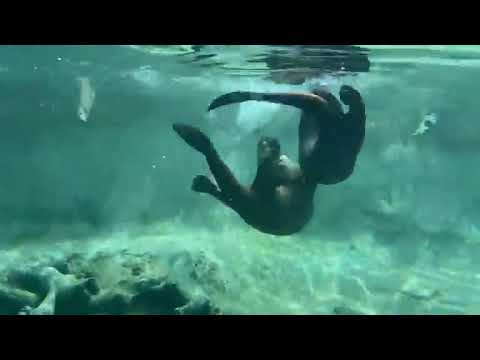A Day with Ken and Marume: Giant River Otters at the Houston Zoo
In the heart of Houston, Texas, nestled amidst the urban hustle and bustle, lies the Houston Zoo, a sanctuary for more than 6,000 animals from all corners of the globe. This time, our journey takes us to the realm of the captivating giant river otters Ken and Marume. Hailing from Jacksonville, these playful creatures, aged two and three, delight visitors and staff alike with their antics and charm.
Ken, the younger of the pair, is renowned for his exuberant nature, while Marume can be easily identified by her distinctive throat patch. This throat patch, a characteristic shared by all giant river otters, is unique to each individual. It is not just mere ornamentation but also crucial in identification and communication, particularly in their wild habitats.
What is truly fascinating about giant river otters is the anatomical adaptations that make them formidable swimmers. Their powerful tails act like rudders, guiding them seamlessly through the water, while their webbed toes enhance their agility and speed underwater. Such adaptations enable them to be proficient hunters, with a diet comprising many fish species, including the bonier tilapia. Interestingly, consuming these bonier fish aids in cleaning their teeth, a natural dental care routine.
But it isn’t just the physical attributes that enchant Ken and Marume. These otters are gifted with various vocalizations, making them one of the most vocal mammal species. Each sound plays a role in communication, from soft hums to screams, whether for locating each other or expressing emotions.
However, life at the Houston Zoo for Ken and Marume isn’t just about swimming and vocalizing. An essential aspect of their daily routine involves providing what the zookeepers call ‘enrichment.’ These activities are designed to stimulate the otters mentally and physically, mimicking challenges they typically encounter in the wild. The icy fish popsicles are a popular form of enrichment for Ken and Marume.
These fish popsicles, a delightful blend of frozen fish, present a problem-solving opportunity for the otters. They seem to derive immense joy from tearing apart and devouring these icy treats, a sight that is both entertaining and indicative of their natural behaviors.
Giant river otters, like Ken and Marume, are also equipped with particular adaptations that aid their aquatic lifestyle. They possess a unique underwater vision system, a helpful adaptation for spotting prey. Additionally, they have evolved mechanisms to keep water out of their ears and noses when diving. Another intriguing feature is their dense fur, which traps a layer of air against their skin, providing insulation and buoyancy.
And let’s not forget their claws! Much like a feline’s retractable claws, the otters’ claws are tools for catching prey and serve a peculiar purpose. Otters use their claws to spread their feces, marking their territory in a manner that might seem odd to us, but is a regular practice in their world.
To conclude, a visit to the Houston Zoo’s otter enclosure is not just a delightful visual experience but also an educational journey into the lives of Ken and Marume. These two charismatic giant river otters, with their distinctive physical attributes, playful behaviors, and fascinating adaptations, offer a unique insight into the remarkable biodiversity of our planet. They remind us of the importance of conservation efforts and the value of each species in the vast tapestry of life.
*****
Summary of Transcript:
The video is a tour of the Houston Zoo featuring the giant river otters Ken and Marume. The otters are given ice pops made of frozen fish, which they enjoy ripping apart and consuming. The otters are from Jacksonville and are two and three years old, respectively. Ken is playful, while Marume has a fully formed throat patch on her chest, which helps identify her. Giant river otters have potent tails and webbed toes that help them move through the water. They eat various fish, including the bonier tilapia, which helps clean their teeth. Otters have individual throat patches, which help identify and find each other in the wild. They have a variety of vocalizations and are charismatic animals. The ice pops are given to them as a form of enrichment to stimulate them mentally and provide a problem-solving opportunity. Giant river otters have adaptations that help them see underwater, keep water out of their ears and nose, and trap air between their fur and skin. They also have claws on their fingers, which they use to spread their poop to mark their territory.
*****
Summary of Description:
Two river otters, Ken and Merume, ate ice pops made with rainbow trout and catfish tails. They can be identified by their unique throat patch patterns, with Merume having a fully formed white patch and Ken having a smaller one near his chin.
*****
Source Description
🧊 🦦 The perfect ice pop doesn’t exist…
Our giant river duo, Ken and Merume, cooled off with two ice pops made with rainbow trout and catfish tails.
How can you tell this duo apart? Merume has a fully formed white throat patch, while Ken has a smaller one near his chin. Each individual has a unique throat patch pattern – similar to human fingerprints.

